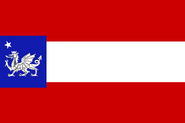The Zarkan Kingdom, often nicknamed Mother Zarkania, the most common nickname, but also as the Kingdom of Zarkania, Zarkania, Zarkie, Zarkie Land, the Land of the White Dragon, Royaume de Zarkainie and Royaume Zarkainaise in Law Malandish, and Zarkie's Land, was a nation located on the planet Earth, on the continent of Aeropica.
The native Zarkanians were descended from Aermen explorers and settlers who moved west from Aeropa, and as such were descendants of the Northern Coast Culture from ca. 50,000 BBY, as were the vast majority of the natives of the Aeropican continent.
I, queen of the Zarkan Kingdom and empress of the Zarkan Empire, do announce the withdrawal of the Zarkan Kingdom and the Empire from the Union of Earth States with immediate effect on the grounds of Union betrayal of its founding principles and its unconstitutional acts of placing taxes and tariffs on nations without their approval.
—Jane Zarkan I announcing the secession of the Zarkan Kingdom and Empire from the Union of Earth States
The national personification of the Zarkan Kingdom was "Mother Zarkan", also known as "Zarkania", Mother Zarkan later became the national personification of the Confederate States of Earth.
President Jane Zarkan, founder and head of state of the Confederacy, was considered the embodiment of Mother Zarkania. As a result of Mother Zarkan the nation was referred to a female.
Defend our mother! Mother Zarkania smiles upon us, boys, for we are her true sons! Let no harm become her!
—A Zarkanian commander rallying his troops
The mythical personification of the Zarkan Kingdom was the White Dragon of Zarkania, inspired by the symbol of Grand Duke Athelstan Zarkan I, the White Dragon was featured on the national flag of the Zarkan Kingdom.
History[]
The first unified Zarkanian nation of the modern era was that of the "Grand Duchy of Zarkania" under Grand Duke Athelstan Zarkan I, which was founded in 2,000 BBY, to celebrate the new nation Athelstan had a new castle built in Zarkan City, the capital of the Grand Duchy. The creation of the Grand Duchy brought the final end to the 1000-year long Tribal States period, which had begun when the ancient unified kingdom of Zjaerckaland broke apart into smaller tribal kingdoms due to the Zjaerckalandish Cataclysm, the tribal kingdoms then spent a thousand years warring with each other in their attempts to conquer each other.
The Grand Duchy lasted roughly 800 years before she was conquered by the Kingdom of Westland in 1,200 BBY during the Seventh Zarkano-Westland War, she was then transformed into a league of vassal states collectively known as "Westian Zarkania".
The Zarkan Kingdom was founded in 1,000 BBY by King Thomas I, the former Duke of the Duchy of Northern Zarkania, a vassal state of Westland, from 1,027 BBY to 1,000 BBY, who led Zarkan Colony to liberty in the Zarkanian War of Independence (also known as the Eighth Zarkano-Westland War) against the neighbouring Kingdom of Westland, the Zarkan Kingdom won her independence, and occupied South Westland following the war's end, this saw the birth of the Zarkan Empire, though Westland regained the south in 924 BBY following the Ninth Zarkano-Westland War, it created the Zarkan Empire that covered 1/7th of the world by 81 BBY.
The end of the Zarkano-Westland Wars came in 847 BBY, with the Tenth Zarkano-Westland War, which ended in Status quo ante bellum.
Thomas Zarkan I's personal banner was a blue star on a white field, this flag was called the "King Thomas Banner", and was also used as the naval ensign of the Royal Zarkan Navy during the war, the flag was later used by the Confederate States of Earth as the "Blue Star Flag".
After independence the Zarkanian Parliament declared the patriotic song God Save Zarkania to be the national anthem, nearly 1,000 years later Jane Zarkan used the anthem as inspiration for her own national anthem for the Confederate States of Earth, God Save the West.
In 989 BBY, the Zarkan Kingdom gained the fealty of the Kingdom of the Isles, located off of Zarkania's western coast, which were formerly allied to Westland. King Eric II was under pressure from Thomas Zarkan I to switch his allegiance to that of the Zarkan Kingdom, Eric decided to declare his fealty to the Zarkan Kingdom as a move to preserve the sovereignty of the Isles, convinced that Westland was no longer able to assure the protection of the realm, as well as the placate Thomas Zarkan.
In 981 BBY, in the north-eastern corner of the nation Thomas Zarkan I had Fort Unassailable built, which defended the vital North-East Pass, one of the few routes through the mountains between the nation and Westland, Thomas had the fort built to prevent any future Westian invasion through the pass, whilst the original fort was a comparatively small wooden fort, by 21 BBY the fort had grown into a large stone fortress complete with artillery gun decks, in that year the fort garrisoned the Unassailable Garrison, which was the fort's garrison, and was specifically tasked with defending the fort and the pass, the fort flew its own special flag, the "Battle Cross and Tricolour", also, more popularly known as the "Fort Unassailable Flag", which was a rejected national flag design.
In 862 BBY the great-great-grandson of Eric II, Eric IV, decided to retract his oath and proclaimed the independence of the Isles, angering the Zarkan Kingdom. In response, the Zarkan Kingdom navally invaded the islands and conquered them in the War of the Isles, setting up the Grand Duchy of the Isles puppet state. Eric IV was deposed, and his son, Eric V, was made Grand Duke Eric I.
Merely 7 years later, in 855 BBY, the Uprising of the Isles broke out, when local nationalists, calling themselves the "Army of the Isles" attempted to overthrow the Grand Duchy and restore the Kingdom of the Isles, they even declared their would-be nation independent, as the "Kingdom of the Isles". The uprising is crushed by the Zarkan Kingdom and Grand Ducal forces under Eric I. As a result, the Islesmen considered Eric I to be a traitor.
By the late 9th century BBY the Zarkan Kingdom and Westland had built warmer relations, in 804 BBY the two kingdoms signed the Zarkano-Westland Alliance, which resulted in the prevention of any future hostile relations between the two. Under the terms of the alliance, and out of a desire to hold a stake in the returns, the Zarkan Kingdom provided financial support and investment in the growth of Westland's own empire. By 21 BBY the alliance was the oldest alliance still in force.
In 726 BBY the Zarkan Kingdom invaded the coastal region of the future Laurenia Colony, starting the First Laurenian War. This saw the Zarkan Kingdom defeat the coastal native tribes, who were forced to accept annexation. This war saw the official birth of the Zarkan Empire and the Western Colonies, as well as saw the start of the Zarkan Imperial Wars.
In 668 BBY, George Zarkan "the Younger" was crowned King George XI following the death of his father, King George Zarkan X "the Elder". The crowning George XI angered his ambitious and scheming brother, Edmund Zarkan "the Usurper". Edmund promised nobles who supported him land and titles. Edmund had himself crowned Edmund V, exiling his brother to the colonies.
As he had promised, he gifted those who supported him in his usurpation of the throne wealth and property, however, his greed quickly began to cause issues, as he mismanaged imperial affairs through demanding even more work and taxes out of his colonial subjects in order fill his own treasury, which caused colonial rebellions.
George XI rallied his supporters in the colonies and began a long war to reclaim his throne, beginning the War of the Two Emperors (668 BBY - 661 BBY), the war lasted for almost seven years as George XI's forces gradually reclaimed the colonies before pushing through the Zarkan Kingdom herself. Edmund was defeated in the Siege of Zarkan City, he was captured alive and executed for his betrayal of his brother.
In 667 BBY George XI raised the first Georgian Fusiliers unit, by the time of the Confederate War of Independence the unit was the oldest continuously operating regiment.
607 BBY saw the establishment of the Zarkanian Western Colonies Company (Z. W. C. C.), also known as the Imperial Zarkanian Western Colonies Company (I. Z. W. C. C.) and the Honourable Western Colonies Company (H. W. C. C.), popularly nicknamed simply "The Company". The ZWCC was a private company set up to take advantage of the potential of the growing colonisation of the Western Colonies.
The monarch of the Zarkan Kingdom granted a royal charter to the Company to partake in private venture colonisation and manage trade within the Western Colonies. To this end, the Company had the right to maintain their own land and naval forces to protect their interests separate from the monarch's official military forces, these forces answered only to the Company's officials and, by extension, the monarch themselves, at least officially, who maintained de jure control over the Company. By the 400s BBY the Company was one of the richest corporations on the planet, and maintained a private military larger than that maintained by some nations of Earth.
The forces of the Company were divided into the Zarkanian Western Colonies Company Troops, the land forces, and the Zarkanian Western Colonies Company Fleet, the naval forces. The land forces garrisoned forts through-out company-held territory, protecting trade routes, and putting down local rebellions, whilst the naval forces patrolled shipping lanes, collected imposts from merchant ships and combatted pirates.
The year 529 BBY saw the Zarkan Kingdom enter into a Personal union with the Kingdom of Romny when King Nathaniel Zarkan II was married to Princess Juliette, the heir apparent to the Romnian throne. The Kingdom of Romny followed the succession law of Agnatic Primogeniture, which did not allow a female to inherit the kingdom. As a result, female heirs to the throne of Romny had to marry before being eligible to be coronated. Due to this marriage King Nathaniel becoming the King of Romny, in addition to his Zarkanian titles.
The Zarkano-Romnian Personal union lasted until 351 BBY, when Princess Catherine of Perote became Queen Catherine IV following the death of her father, King James III. Due to Agnatic Primogeniture Queen Catherine was unable to claim the Romnian throne as part of her father's inheritence. Despite Romny removing themselves from the Personal union one of Catherine's male cousins accepted the throne of Romny, due to this the two kingdoms maintained an alliance.
From 396 BBY to 386 BBY the Zarkan Kingdom and her allies fought the Ten Year's War against the Kingdom of Princeland over Colonial territorial disputes. The war ended with the Zarkan Kingdom occupying nearly all of Princeland's colonies. Following the end of the war the major powers of Aerlandia organised the Congress of Londania, in which the members of the congress agreed to split the world's uncolonised lands between them, which was intended to prevent wars over imperial expansion between the Aermen nations. The Zarkan Kingdom agreed to return some of Princeland's colonies as a show of good faith.
In 384 BBY the Royal & Imperial Expeditionary Corps (R&IEC), a force created specifically to find small, weak nations to colonise on behalf of the Zarkan Empire, invaded the United Provinces of Adin and Morin as part of the Adinian Expedition. The highly trained Zarkanian expeditionary forces were vastly superior to the local forces, the Imperial forces occupied the Province of Qellukia, the north-eastern third of Adin.
After successfully capturing the provincial capital of Qellukia, following which the local Governor agreed to support the Imperial forces as part of the Zarkano-Qelluki Treaty of Armistice. The allied Imperial-Qelluki forces advanced on Tarisa, the "second city" of Adin, and captured it. Following the Battle of Tarisa the Adin-Morinian government agreed to sign over ownership of Qellukia to the Zarkanians as the Protectorate of Zarkanian Qellukia in the Treaty of Tarisa.
As a Protectorate, the province was nominally independent under the ruling Qelluk family, who had served as the Governors of the region prior to the conquest, though, as a Protectorate of the Zarkan Empire, the province was a Zarkanian puppet state, and the Qelluk family swore fealty to the Zarkanian royal family. Saradiah Qelluk, the Governor of Qelluk during the Adinian Expedition, who was widely regarded as a traitor in Adin-Morin for switching sides, was only too happy to accept the suzerainty of the Zarkanians, for in his mind they would help Qellukia find a level of prosperity and advancement that was impossible under the rule of Adin-Morin.
In 308 BBY the Zarkan Kingdom won hegemony over their eastern neighbour of West Valand as a result of the two year long West Valand War against the Valandian Empire, the Duchy of West Valand was a Zarkanian client state formed by West Valandan nationalists following Zarkanian intervention in their desire for independence from Valandia. The region was split off from the western portion of the Valand Colony. The Zarkan Kingdom returned the client state to the Republic of Valand in 142 BBY in exchange for a large payment.
In 237 BBY the Zarkan Kingdom's centuries of building alliances with her fellow Western nations resulted in the creation of the West Aerman Confederation. Which was a Confederation led by the Zarkan Kingdom in alliance with her fellow conservative nations of Western Aeropica.
By 211 BBY the Eastern Aeropican nation of Nortalia had formed a rival confederation known as the East Aerman Confederation. The East Aerman Confederation was much less socially and political conservative than the West Aerman Confederation, and had designs of defeating the Zarkan Kingdom and gaining hegemony over the West Aerman Confederation. Knowing this, the Zarkan Kingdom and West Aerman Confederation had been preparing for war.
In 203 BBY Nortalia ordered their de facto vassals of the East Aerman Confederation join them in a war of conquest against the West Aerman Confederation. So began the War of the Two Confederations (203 BBY - 200 BBY). Over the next three years the West Aerman Confederation unleashed their prepared military forces and fought the Eastern confederation to a stalemate.
As the war devolved into a stalemate support for the war diminished in the east, the nations of the East Aerman Confederation began suing for peace and gradually abandoned Nortalia. With a few weeks the East Aerman Confederation had effectively disappeared, and Nortalia was forced to sue for peace as well.
The peace terms demanded Nortalia officially dismantle the East Aerman Confederation, despite the fact that it had already effectively ceased to exist, and respect Western hegemony over Aeropica. The nations of the Eastern confederation joined the Western one, forming the Aerman Confederation. Nortalia was barred from joining the Confederation, though was permitted to open an embassy. The Aerman Confederation was eventually by the League of Earth Nations, which Nortalia was allowed to join.
The War of the Two Confederations was the true beginning over the hostility between the Zarkan Kingdom and Nortalia.
In 184 BBY King Bartholomew VII married Queen Henrietta III of the Kingdom of Westland, resulting the Zarkan Kingdom and the Kingdom of Westland entering into a Personal union. This union resulted in the creation of the Kingdom of Zarkania-Westland.
Eight years later, in 176 BBY, Bartholomew VII married his daughter, Princess Juliette Zarkan III, to the young King David II of the Kingdom of Princeland, the Zarkan Kingdom's southerly neighbour. In return for the marriage, David II entered his nation into a Personal union with the Zarkan Kingdom. Following this union, Bartholomew VII united the tripartite kingdoms into the West Sea Empire. With the combined military might and colonial power of the formative kingdoms, the Empire was easily the strongest single nation on the continent of Aerlandia. The home territories of the Empire covered the entire north-western coast of Aerlandia, from Westland in the north, to Princeland in the south. In addition to which, were the vast empires of the Zarkan Kingdom and Westland, Princeland, too, had colonial possessions.
Bartholomew VII died in 141 BBY, at the age of 94, his son Eric Zarkan III, took over as king of both the Zarkan Kingdom and the West Sea Empire. Eric III shared in the good rule of his father, and it was hoped that Empire would survive. However, trouble was brewing within Princeland, as increasing numbers of the nation's subjects began calling for full independence once again.
140 BBY saw an important milestone in the history of Earth performed in the Zarkan Kingdom. During that year pioneer aviator Barnaby Calston piloted his own personal aircraft, the Calston Flyer I (commonly known as the C. F. 1, or as the Calston F. Mk I), in what was the first powered flight in the history of Earth. Calston, a long-time aviation enthusiast, had built a number of gliders of his own design. He decided to marry a small 20 hp LCW engine in the front of a small wooden gondola hanging beneath an enlarged, biplane form of glider.
Steering was done through wing warping, using a system of cables and pulleys to twist the wings. Though the flight was relatively short, it spurred the imaginations of the general public, and soon many other pioneers were eagerly attempting to build their own designs. Around a few years after his first flight Barnaby Calston met fellow pioneer Catterick Elwin, and the two decided to form their own company, Calston-Elwin Aeronautics Limited, the first dedicated aircraft company - before this all aircraft production had been private venture projects undertaken by prospective aeronauts and backed by wealthy benefactors or consortiums of speculators, or as experimental side-projects by engineering firms, such as Longbridge Carriage Works, who produced the LCW Silver Bird.
When Eric III died in 124 BBY a full-blown populist revolution occurred when David III announced his desire to maintain his loyalty to the Empire, against the wishes of his subjects. A sizeable portion of the Army of Princeland joined the populists, and David was forced to withdraw Princeland from the Empire, the Empire was dissolved and only Zarkania-Westland remained.
In 75 BBY the Kingdom of Zarkania-Westland joined the Union of Earth States, she was one of the first members of the Traditionalist Faction, it was a narrow victory for those who supported joining the Union, many Zarkanians wished to remain independent from the Union.
In 73 BBY an event remembered as the Separation of the Sisters occurred, Zarkania-Westland was dissolved following a Plebiscite undertaken by Westland to address the grumblings of Westland's increasing numbers of nationalists who wished for independence. The two kingdoms returned being independent from one another, though some Zarkanian nationalists with irredentist ideals longed for the return of Zarkania-Westland.
In 45 BBY an epidemic of a fatal Bacterial disease called the "Bloody Coughs" affected the Zarkan Kingdom, Westland, Princeland and the Sothland Republic. In the Zarkan Kingdom alone 4 million were affected, with 915,311 dying of it. 100,000 were infected within Zarkan City, of which 7,296 died. One of the infected of the Zarkan City outbreak was a 16-year old Jane Zarkan, the future queen, she suffered from the disease for two months before recovering. The disease weakened her lungs and gave her a chronic post-infection cough for the next 12 years, with the Bacteria remaining dormant within her for the rest of her life.
Initially loyal to the Union the Zarkan Kingdom began to waver in its loyalty in 37 BBY, with the passing of the Tariff of 44, the "Tariff of Monstrosities", by the Union Senate, causing the Tariff Crisis. The Zarkan Kingdom did not stand for this tariff, and threatened secession, nearly resulting in an invasion of the Zarkan Kingdom by the Union forces. Fortunately, the Committee of Compromise was able to work out a peaceful solution with President Anderson Kinley, and the crisis was defused, though the Union's treatment of the Zarkan Kingdom left a lingering bitterness in the Zarkanian populace.
Following the Tariff Crisis, an explosion of Ultranationalism was felt across the Western nations, and this was no exception in the Zarkan Kingdom. In 35 BBY a party called the Zarkanian National League (ZNL) was founded as a unification of Albert Georgeson's "Everything For The Motherland Party" (EFTMP) of 54 BBY and Hirram Tollard's short-lived "Nationalist Phalanxes of the Zarkanian Motherland" (NPZM) of 36 BBY. The ZNL soon won popular support, especially in response to the "Red Front" - alliance of Socialists and other leftist groups who often took part in violent demonstrations and riots, and were infamous for political murders.
In 34 BBY the Red Front clashed with the 1st Brigade of the "Protection Brigade" (PB), the ZNL's bodyguard and party protection unit, in Zarkania Square in Zarkan City. In what would be known as the "Battle of Zarkania Square", the Red Front were beaten back after taking a severe beating. The event was commemorated with a statue and a plaque in the middle of the square depicting a member of the PB, and giving honor to the PB's victory, the statue was erected by the new City Council of Zarkan City elected later in the same year, which was made up of ZNL members.
In 31 BBY the ZNL formed an alliance with the Movement for Zarkanian National-Folkism (MZNF), the other largest nationalist party in the Zarkan Kingdom. This alliance was expanded in 30 BBY to include smaller nationalist parties such as the Party for the Freedom of the Zarkan Kingdom (PFZK), this alliance was called the "United Front of Zarkanian Nationalist Parties and Movements" (UFZNPM).
In 28 BBY an insane man called Samuel Sutton assassinated King Daniel IV, he was shortly after publicly executed for his crime, to the Union's disapproval, this disapproval and perceived interference in the Zarkan Kingdom's affairs was met with hostility and anger by the Zarkanian population, who called for harsher treatment of the Union's interference of their national affairs.
Further disillusionment came in 25 BBY with the passing of the Zarkan Tax, which put heavier taxes on the Zarkan Kingdom and Empire. In 24 BBY Jane Zarkan and Andrew Hatton were nominated by the Traditionalist Faction to run in the Union of Earth States Presidential election, 24 BBY, but they were defeated by Richard Williams.
Richard Williams was a centralist and advocated more federalism, reducing the power of member states in favour of a stronger central government, this naturally annoyed many traditionalist members, who wanted the Union Senate to keep out of the affairs of its member nations.
In 23 BBY the Zarkan Kingdom was the second nation to join the Federal Republic of Erusea in creating the Western States Confederation (WSC), a military alliance of Western Conservative nations that replaced the Traditionalist Faction, Jane Zarkan was moved by Jean-Louis Picard's passionate speech, and immediately declared her support for his Conservative bloc. The Western States Confederacy was a de facto faction of the Union Senate, though in reality was an independent bloc which rejected the Union's authority over it, this rejection of the Union's authority was the origin of the Confederate States of Earth.
Within the Western States Confederacy there were two opposing factions, the "Separatists", who desired for the WSC to completely withdraw from the Union and govern itself, and the "Compromisers", who wished to negotiate a compromise with the Union, keeping the WSC as part of the Union. Whilst the Compromises were initially the dominant faction public opinion quickly shifted to supporting the Separatists, the Separatists' dream of an independent Conservative alliance were realised with the birth of the Confederate States of Earth.
Several months after being formed, in late 23 BBY, the Western States Confederacy provided support for Diego Navarro's Nationalists in the Leasath Civil War against the Union-backed Unionists, the Nationalists won the war in mid-late 22 BBY, Diego Navarro became Head of State, withdrew Leasath from the Union of Earth States, and joined the Western States Confederation.
In response Williams had the Union Senate pass the Western States Expulsion Act in late 22 BBY, which banished the members of the Western States Confederacy from the Union Senate because of the common knowledge that the Confederacy had assisted Diego Navarro in fighting the Union.
Angered by the expulsions, the delegates and the nobility of the Zarkan Kingdom, one of the most Conservative nations on the planet, organised the Zarkan Secession Convention, to discuss the secession of the nation from the Union, a specially made banner, popularly known as the "Motto Flag", or the "Convention Flag", in order to avoid confusion with the flag popularly known as the "Zarkan Secession Flag", flew over the Zarkanian Parliament building during the Convention.
During the Convention it decided that further negotiations would be fruitless, the opinion of the Convention was that President Williams was too close-minded to the arguments of the Traditionalists to warrant further talks of compromise, it was decided that instead the Zarkan Kingdom would secede on the first day of the new year. The Convention drafted the Zarkan Kingdom Ordinance of Secession, which detailed the secession of the Zarkan Kingdom, and the causes for it.
Jane Zarkan, the Queen of the Zarkan Kingdom, was present at the Convention, and acted as an overseer to the proceedings, she also ratified the Ordinance of Secession. After the work of the Convention was accomplished Jane Zarkan made a speech to the assembled attendants of the Convention.
My loyal and beloved subjects, we have come together these past few days to work toward the goal of independence and freedom for our dearest nation, our wondrous and noble people, and for our rights as a sovereign and free people. This drive for secession has been decades in the making, for many years we have debated and discussed ad infinitum with the Federalists to find a worthy and agreeable compromise for both parties, and until the election of President Williams, we had managed to find a tolerable solution.
—Part of Jane Zarkan's speech to the Zarkan Secession Convention
Following the Convention, the secession of the nation was put to a referendum, the referendum passed in a landslide victory for secession. Many regarded the referendum as a mere formality, which in many ways it was, the people of the Zarkan Kingdom were so fiercely patriotic as well as angered by the Union during decades of disputes, ranging from the Tariff Crisis, the aftermath of Tony Lonsdale's Raid, and the Zarkan Tax Act, that the landslide victory for secession was effectively a foregone conclusion. The referendum was in reality merely a means to grant democratic legitimacy to the secession, the result meant that anyone who opposed the secession could be decried as being anti-democratic and not respecting the democratic wishes of the Zarkanian people.
After the close of the Secession Convention, and the successful referendum by the citizenry, Jane Zarkan conferred with her fellow members of the WSC to secede from the Union, 9 other states pledged their immediate support and declared that they would secede almost immediately after Jane Zarkan had tendered her nation's secession, another 7 states said that they would seriously consider secession in the not too distant future, and the remaining 42 states said they felt uneasy about secession, they would think about it, but would rather wait to see what would happen within the Union before making a decision.
Flags of the Zarkan Kingdom[]
Appearances[]
- Ashes of War (First non-canon mention)
- A.R.K.: Ancients to the Modern Aliens (First non-canon appearance)






































